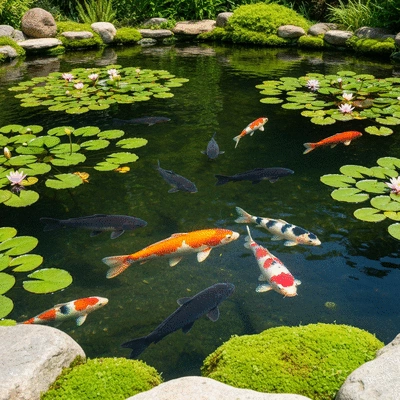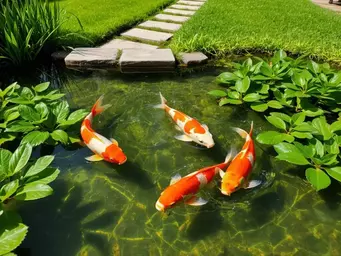Optimal Pond Size
A larger pond ensures better water quality and reduces stress for fish.
- First Koi: 1,000 gallons
- Each Additional Koi: 250 gallons
- Supports stable environment, reduces aggression.

What if the health and happiness of your koi depended on the size and location of their pond? Understanding these fundamentals can transform your outdoor oasis into a thriving ecosystem. Let’s dive into the essentials of koi pond care.
When planning a koi pond, three essential aspects directly impact the health and vibrancy of your koi: size, depth, and location. These elements work together to create an optimal environment.
A larger pond ensures better water quality and reduces stress for fish.
Crucial for temperature regulation and protection against predators.
A well-chosen spot enhances koi health and simplifies maintenance.
As an avid koi pond enthusiast, I've come to realize just how crucial pond size is for the overall health and well-being of your koi. The size of your pond directly influences not only the growth of your fish but also their welfare. A larger pond offers more space for swimming, reduces stress levels, and helps maintain better water quality, which is essential for keeping your koi vibrant and lively. For more in-depth information on maintaining optimal water conditions, you can refer to this NOAA technical memorandum on aquaculture water quality.
Moreover, an adequately sized pond can help prevent overpopulation, which may lead to unhealthy living conditions. When planning your koi pond, consider how many koi you intend to keep and the size of those fish, as it will inform your design choices and ultimately, your koi’s happiness!
To truly appreciate the importance of size, you must understand that koi can grow quite large, sometimes exceeding 3 feet in length! This means your pond needs to accommodate not just a few fish, but the potential for a thriving community.

Let's talk about depth! Maintaining an appropriate pond depth is vital for ensuring temperature regulation and providing shelter from predators. In regions with temperature fluctuations, deeper ponds can help stabilize the water temperature, allowing koi to thrive even as seasons change. Think about how deep your pond should be; generally, a depth of at least 3 feet is recommended to protect your koi from sudden temperature swings. The National Institutes of Health provides insights into optimal aquatic environments, highlighting the importance of water parameters for fish health.
Additionally, deeper ponds provide a refuge for koi during hot weather or when predators are nearby. Having that extra depth can mean the difference between a peaceful pond and a challenging environment for your beloved fish!
The location of your pond is just as important as its size and depth! A well-placed pond can enhance the health and vibrancy of your koi. When choosing a location, consider the amount of sunlight the pond will receive; koi appreciate a mix of sun and shade. Too much sun can lead to overheating, while too much shade may hinder the growth of beneficial algae and plants. For more information on environmental factors impacting aquatic ecosystems, you can consult this research on environmental variables affecting aquatic life.
By thoughtfully selecting your pond’s location, you can create an environment that promotes healthy koi and keeps maintenance manageable. Your koi pond should be a beautiful focal point in your yard, and the right spot can make all the difference!
When designing your koi pond, consider incorporating aquatic plants into your layout. Not only do they enhance the aesthetic appeal of your pond, but they also play a crucial role in maintaining water quality by absorbing excess nutrients and providing shade for your koi. Additionally, these plants can create natural hiding spots, helping to reduce stress in your fish!
A good rule of thumb is at least 1,000 gallons for the first koi to ensure optimal health and reduce stress. Each additional koi requires approximately 250 gallons.
A depth of 3 to 5 feet is recommended. This depth helps stabilize water temperature, protecting koi from sudden temperature fluctuations, and provides shelter from predators.
An ideal location offers a mix of sunlight and shade to prevent overheating and support beneficial algae growth. It should also be away from large trees to minimize debris and runoff, and allow for easy maintenance access.
Good water quality is crucial for koi health, growth, and overall well-being. Larger ponds help maintain better water quality by diluting waste and supporting a stable ecosystem.
Aquatic plants enhance the pond's aesthetics, absorb excess nutrients to improve water quality, and provide natural shade and hiding spots for koi, which helps reduce stress.
As we wrap up our exploration of creating the perfect koi pond, let’s recap the best practices for ensuring a healthy environment for your koi. It’s essential to focus on three key aspects: optimal size, adequate depth, and suitable location.
First, the size of your pond must cater to the number of koi you plan to keep. A good rule of thumb is at least 1,000 gallons for the first koi and an additional 250 gallons for each subsequent fish. Next, depth is crucial for maintaining water temperature and providing shelter from predators. A depth range of 3 to 5 feet is generally recommended. Lastly, selecting a location that balances sunlight and shade will enhance the health of your aquatic ecosystem.
By following these guidelines, you're setting the stage for a vibrant and thriving koi pond that brings joy and serenity to your outdoor space!

Now that you have a solid understanding of what it takes to create a stunning koi pond, it’s time to put these insights into action! Start by sketching your pond’s layout and considering the elements we've discussed.
Whether you're diving into your first pond project or enhancing an existing one, remember to take it one step at a time. I encourage you to utilize the resources available at Best Koi Ponds, where you’ll find guides, equipment reviews, and tips tailored specifically for koi enthusiasts like you. Let’s transform your dream into reality!
I would love to hear about your koi pond adventures! Sharing your designs and experiences helps build our wonderful community of koi enthusiasts. Feel free to comment below or connect with us on social media. Whether it’s your first pond or your latest upgrade, your journey can inspire others!
As you continue your koi pond journey, consider checking out some valuable resources that can further enhance your knowledge:
These resources will equip you with the information needed to maintain a thriving koi pond.
Lastly, let’s not forget about the health of your koi! Regular water testing is vital to prevent diseases and maintain a balanced ecosystem. Here are some common koi diseases to watch out for:
Preventive measures include keeping your water clean, monitoring fish behavior, and consulting experts when needed. At Best Koi Ponds, we’re here to support you in every step of maintaining your koi’s health.
Here is a quick recap of the important points discussed in the article:
Maintaining Koi Pond Water Quality

Did you know that the clarity and quality of your koi pond water can significantly influence your fi
Creating a Healthy Koi Pond
Maintaining Koi Pond Water Quality
Koi Pond Shape and Size Guide
Koi Pond Water Quality Solutions
Naturalizing Your Koi Pond Plants